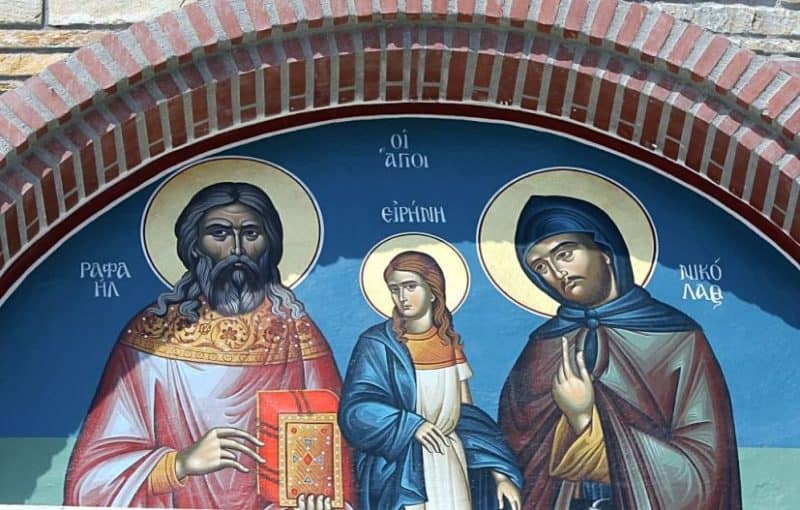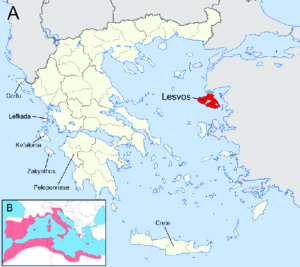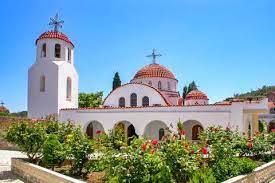And we do mean newly-revealed. At least by my (old man’s) standards.

from Greek City Times
It began in the year 1959, on the Greek island of Lesvos (also known as Mytilene). The Martyr Raphael appeared in a dream to the priest of the village of Thermi, identified himself, then began to tell him his story – how he and others had been martyred there by the Turks on Bright Tuesday, 1463, which fell that year on April 9. This was the beginning of many appearances to many people, and the revelation of the full story.
First the background. For as long as anyone could remember, on Bright Tuesday the villagers had gone to a nearby hill to pray, some accounts say to celebrate a Divine Liturgy. Nobody knew why. (In the Old World, people often hang onto old customs like this, even if they don’t understand them. We’re not so wise over here.)
There were ruins of a building there, and also vague memories of a monastery once having been there, but that was all. Shepherds and occasionally village people, even Turks, also told of seeing a monk walking up there from time to time, and some reported the faint sound of bells and the smell of incense. During the Ottomann occupation, the local Turkish authorities even conducted an investigation, but finally gave it up since there seemed to be no explanation.
Finally in the year 1959 a pious layman of the village, Angelos Rallis, decided to build a chapel there. In the process of excavating they discovered human bones. Mr Rallis, thinking they might be relics of some sort, had the man in charge of the excavations, one Doukas Tsolakis, put them carefully in a sack. Some accounts say that noises came from within the sack, and a sweet fragrance. One of the workmen, a non-believer, gave the sack a kick, and his leg suddenly went numb. The priest was called to say Trisagion Prayers over the bones. The evening before, he wondered what name he should use as he conducted the prayers – and that night Saint Raphael made his first appearance. The first of many.
And now the even more startling part of the story began. Father Raphael not only identified himself but began to reveal the full story of his life and death. He had been Igumen (abbot) of the little monastery there. And not only his life but also of those who had been martyred with him: the Deacon Nicholas, the young girl Irene and others.
But soon the stories didn’t depend on him alone. Saints Nicholas and Irene also began appearing to many inhabitants of Lesvos in dreams and apparently sometimes while they were awake! and told their stories in full detail. The final confirmation came when the graves were excavated, to reveal the three martyrs with their relics bearing the marks of their dreadful martyrdoms, just as they had described them.
 from Ilias Strachinis (at Researchgate)
from Ilias Strachinis (at Researchgate)
Their story, briefly: Raphael had been born about 1410 on the island of Ithaca, off the west coast of Greece, baptized with the name George, the name Raphael given him when he became a monk. He was ordained to the priesthood, had served in Athens, spent time studying in France, where he met the Deacon Nicholas, a native of Thessaloniki, who followed him to the island of Thrace. In 1453 the Great City Constantinople fell to the Turks, and then in 1454 so did Thrace. Father Raphael and Deacon Nicholas fled to Lesvos, just off the west coast of Turkey, and settled in the Monastery of the Theotokos.
In 1462, the Turks invaded and conquered Lesvos. For a while they left the monastery alone, but then a year later it began. Irene was the twelve year old daughter of the village mayor Basil and his wife Maria. The three of them ran to the monastery to warn them that Turkish soldiers were on the way. And then… and remember that this was an assault not on Greek soldiers but on unarmed civilians.
If you have a weak stomach, you may wish to skip over the italics.
The Turkish soldiers cut off one of Irene’s arms and drove long nails into her skull and body, as her parents looked on, then put her in a large clay pot, lit a fire beneath it and let her suffocate to death. After her parents had witnessed this, the Turks killed them as well.
Saint Raphael was then tied to a walnut tree upside down and his head cut off, not in the usual way but through his jaws.
Saint Nicholas, who had witnessed all this, also was tied upside down to a walnut tree and tortured, during which his heart gave out and he died.
Raphael’s relics were uncovered on June 13, 1960, his jaw located somewhat away from his skull. His engolpion (a metal image of the Pantocrator, which hung on a chain about his neck) was discovered near his bones.
Irene’s grave and the clay cask were unearthed on May 12, 1961. .
Nicholas’ relics were found somewhat later.
Also the relics of martyred nuns were found, including the Abbess Olympia. Also martyred were the village schoolmaster Theodore and Eleni, the fifteen year old cousin of Irene.
All this was exactly according to the description and directions given by the three Martyrs in their appearances.
Some years later the monastery itself was destroyed by pirates. Excavations uncovered its ruins, with frescoes on the walls and tile floors.
Though the entire story had been forgotten, the villagers never forgot to go to the hill every Bright Tuesday
 The three martyrs even revealed how they had looked before their deaths. This you can see for yourself in their icons, the original of which was “written” by a master iconographer Photios Kontoglou.
The three martyrs even revealed how they had looked before their deaths. This you can see for yourself in their icons, the original of which was “written” by a master iconographer Photios Kontoglou.
from Ορθογνώσια
The story continues into our times. On the place of their martyrdom, a large monastery now exists, which receives thousands of pilgrims every year. Besides the relics of the saints and the catholicon (primary church) in honor of Saint Raphael, there is another church in honor of Saint Mary Magdalene, and also a building with thirty rooms for the nuns, t wo large guesthouses for pilgrims, and a museum. I read somewhere (can’t seem to document it now) that some nuns have come from many places in the world, sometimes after they also had visits from Saint Raphael.
wo large guesthouses for pilgrims, and a museum. I read somewhere (can’t seem to document it now) that some nuns have come from many places in the world, sometimes after they also had visits from Saint Raphael.
from greeka.com
There have, not surprisingly, been many reports of miracles. Here is one example: http://full-of-grace-and-truth.blogspot.com/
These Martyrs were formally recognized as saints by the Patriarch of Constantinople in 1970.
Holy Martyrs Raphael, Nicholas, Irene and those with you, pray to Christ our God to save our souls.
If you want to know more of the story (and there is much more), you might read Dr Constantine Cavarnos’ “Modern Orthodox Saints series: Saints Raphael, Nicholas, and Irene of Lesvos”, available from (where else?): https://www.amazon.com/gp/product/0914744887/ref=dbs_a_def_rwt_bibl_vppi_i0amazon!
My account above was culled and condensed from Μοναστήρια της Ελλάδας, Full of Grace Blogspot, and the OCA website.
Postlude
1 Many living here in the Western world (especially the Protestant West) think the age of saints and miracles is long gone. Not with us Orthodox it isn’t – nor with Roman Catholics, of course. God continues to create many saints in Hia Church, and through them a multitude of miracles.
Do you know the very similar story of the Newly Revealed Martyr Ephraim of Nea Makri (near Athens)? In 1950 he revealed himself to a hermit nun his existence and the story and location of his relics – which were found as he had said. I understand he still appears to people. But that’s a story for another time.
We Orthodox are still right in the midst of the age of saints and miracles, which began when Jesus Christ became Incarnate and will continue till He returns in Glory.
2 But meanwhile, why does this seem to be chiefly an Old World phenomenon? Why are we (even apparently we Orthodox) in the “New World” so short of miracles? We could understand that in Western Europe, where most people have pretty much given up on Christianity. But people on this side of the Atlantic have not. The United States, statistically at least, is still one of the most Christian countries in the world. So where are all the saints? all the miracles? I have a couple of guesses, but I’ll let you go first. Do you have any possible explanations? If so, please add a comment.
Regarding Cyprus, I highly recommend the book “The Icon Hunter”, by Tasoula Hadjitofi (available on Amazon). Tasoula is a Cypriot exile from the occupied area, and has much to say on the plight of Cyprus.
“From the Holy Mountain”, by William Dalrymple, is an excellent survey of the Christian communities of the Middle East, as they stood in the late 1990s, just on the eve of the calamities of the past 20 years.
Both books are real eye-openers.
I believe miracles are all around us all the time! Our hearts are hardened so we credit our ‘luck’ or science or just being at the right place at the right time. Not so! God is ever present in our lives. We just need to awaken from our stupor! I really enjoy reading your blogs. Fr Bill. May God continue to grant you many many years.
Just a retread Orthodox whom the Lord granted His Mercy upon ! AT
Thanks, AT.
In one way everything is a miracle. Everything that exists, everything that happens is by the direct action of God. Even evil exists by taking what God is doing and twisting it out of shape.
Skip, I never replied to you. Forgive me. I don’t know “The Icon Hunter” but will look it up – as soon as I start to get through the other 7 books I’m reading now. “From the Holy Mountain” is a lovely, depressing book. Dalrymple said he wrote it in imitation of “The Spiritual Meadow” by Saint Sophronios, written in the last days of the Christian Empire in the Middle East. Dalrymple intentionally wanted to record the last days of Christianity in the Middle East. It hasn’t quite come to that yet, but almost. In the Blog, did I ever recommend a group “In Defense of Christians”? a non-profit non-partisan group based in Washington DC, specifically to defend Christians of all stripes in the Middle East. https://indefenseofchristians.org/ If anyone here present knows more about IDC than I do, please speak up.